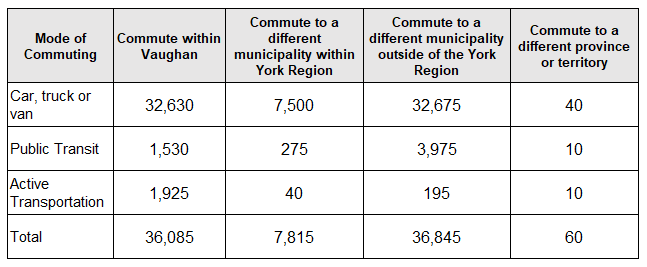2021 Census Insights and Findings – Commuting Characteristics
Key highlights
- In 2021, 89 per cent of employed residents in Vaughan over the age of 15 commuted by car, truck or van as a driver or passenger.
- Nearly two-thirds (63 per cent) of employed Vaughan residents or 63,360 workers leave for work between 6 a.m. and 8:59 a.m.
- More than 53,200 Vaughan residents reported home as their usual place of work
- In 2021 place of work status for 82,925 employed Vaughan residents included their usual place of work in a physical office setting, for 53,225 employed Vaughan residents their place of work status was noted as working from home
- The number of Canadians that commuted by car in May 2022 rose to 12.8 million, exceeding 2016 levels, while reported public transit use remained below pre-COVID-19 levels with only 1.2 million users.
INSIGHTS and Findings
Canada and Ontario
Commuting is a daily activity for millions of Canadians and directly affects how they spend both their time and money, commuting patterns have important economic, and infrastructure-related implications.
The number of Canadians that commuted by car in May 2022 rose to 12.8 million, exceeding 2016 levels, while public transit use has remained below pre-COVID-19 levels and only 1.2 million users.
Between 2016 and 2021, the number of Canadians commuting by car, truck or van as a driver or passenger declined by 1.7 million people. The largest decline in car commuters, occurred among Canadians working in public administration (-235,000 people, or -28.2 per cent); finance and insurance (-224,000, or -47.8 per cent); professional, scientific, and technical services (-224,000, or -32.1 per cent); and educational services (-216,000, or -22.0 percent). The declines noted in these industry sectors were identified as sectors more easily able to adopt work-from-home arrangements for employees.
The number of people taking public transit to work fell from 2 million in 2016 to 1 million in May 2021, the first reported decline since the census began collecting commuter data in 1996. However, with most public health restrictions removed across Canada and Ontario in 2022, the number of car commuters reported in May 2022 exceeded 2016 findings and rose to 12.8 million. Public transit use remains well below pre-COVID-19 levels with a reported 1.2 million users. Due to the pandemic, the decline in car commuters resulted in fewer cars on the road and faster trips to work.
City of Vaughan
In 2021, Commuting to work via car, truck or van as the driver or passenger was the most common mode of commuting for 89 per cent of employed residents in Vaughan over the age of 15. By commuting duration to their place of employment, 35 per cent of residents had commutes between 15 and 29 minutes, 27 per cent of residents had commutes between 30 to 44 minutes. More than 63,300 or 63 per cent of employed residents left for work between 6 a.m. and 8:59 a.m. In 2021 place of work status for 82,925 employed Vaughan residents included their usual place of work in a physical office setting, for 53,225 employed Vaughan residents their place of work status was noted as working from home.
Nearly half of Vaughan residents (32,630) are commuting to their place of work in Vaughan via car, truck or van, and 32,675 employed Vaughan residents are commuting to a municipality outside of York Region via car, truck or van.
Figure 1: Commuting flows by destination for Vaughan Residents, 2021

